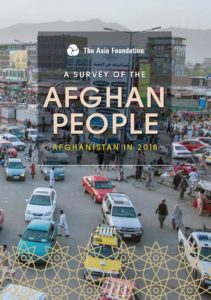By Farrah Azeem Khan
According to The Asia Foundation’s 2018 Survey of the Afghan People, women’s rights and participation in Afghanistan are improving, but very slowly. The broadest and longest-running nationwide poll of Afghan attitudes, the Survey has gathered the opinions of more than 112,000 men and women since 2004, providing a unique longitudinal portrait of evolving public perceptions of security, the economy, governance and government services, elections, the media, women’s issues, and migration.
Although the current Afghan government is publicly committed to women’s rights and empowerment, women continue to face significant barriers to exercising those rights. It was not always thus. From the 1930s to the early 70s, Afghanistan was relatively liberal—to the point that Kabul was often referred to as the Paris of Central Asia. In subsequent decades, however, women experienced significant repression, culminating in large-scale violations of women’s rights and violence against women under the Taliban, who enforced strict gender segregation and the elimination of women from the public sphere.
Since the removal of the Taliban regime in 2001, women have made substantial gains. Women’s rights were enshrined in the national constitution of 2003, and successive national governments have vowed to protect women’s rights, eliminate violence against women, and support women’s economic empowerment and political participation. The Afghan constitution and the Law on Elimination of Violence against Women afford rights, protections, and opportunities to women that are unprecedented in the region and among other Muslim countries.
The 2018 findings are encouraging when it comes to women’s access to justice. More women than men (21.8% vs. 16.4%) reported bringing family disputes to court, the Huquq Department, or the local shura or jirga, progress that can be partly attributed to three agencies of the Afghan government—the Ministry of Women’s Affairs, the Attorney General’s Office, and the police—which have established specialized units to provide support services to women in cases of violence and civil disputes. Media and public awareness campaigns led by civil society organizations and international donors are also making women more aware of their rights. In many ways, this progress is a major collective achievement of grassroots activists, CSOs, the Afghan government, and the international community since 2001.
Waning support for traditional practices such as baad and baddal is another bright spot for women (figure 1), one of the few areas related to women’s rights that has improved each year since 2004. Baad is the practice of giving away a daughter to settle a debt or a dispute between families. Baddal is the exchange of daughters in marriage between families, mostly for economic reasons. Both these practices neglect women’s choice in marriage. This year, just 9.5% of respondents agree that baad is an acceptable practice, down from 12.0% in 2017 and 18.0% in 2016, and the same downward trend holds true for baddal, which just 25.2% of respondents find acceptable in 2018, down from 29.1% in 2017 and 31.8% in 2016. Conversely, the acceptance of miras—a daughter’s right to inheritance from her father—has continued to climb, with 90.2% of Afghans now agreeing that women are entitled to inherit. And despite a long tradition of child brides in Afghanistan, some 36.4% of men and 29.0% of women in 2018 say the ideal age for a girl to marry is 18 years.
Local, national, and international activists and organizations must work as hard as ever for women’s rights and empowerment in Afghanistan. The Foundation’s 2018 Survey of the Afghan People provides valuable data that can be used by the Afghan government, the international community, researchers, and the media to support evidence-based policymaking and improve the public debate about women’s rights in Afghanistan.
Download the full report HERE.


